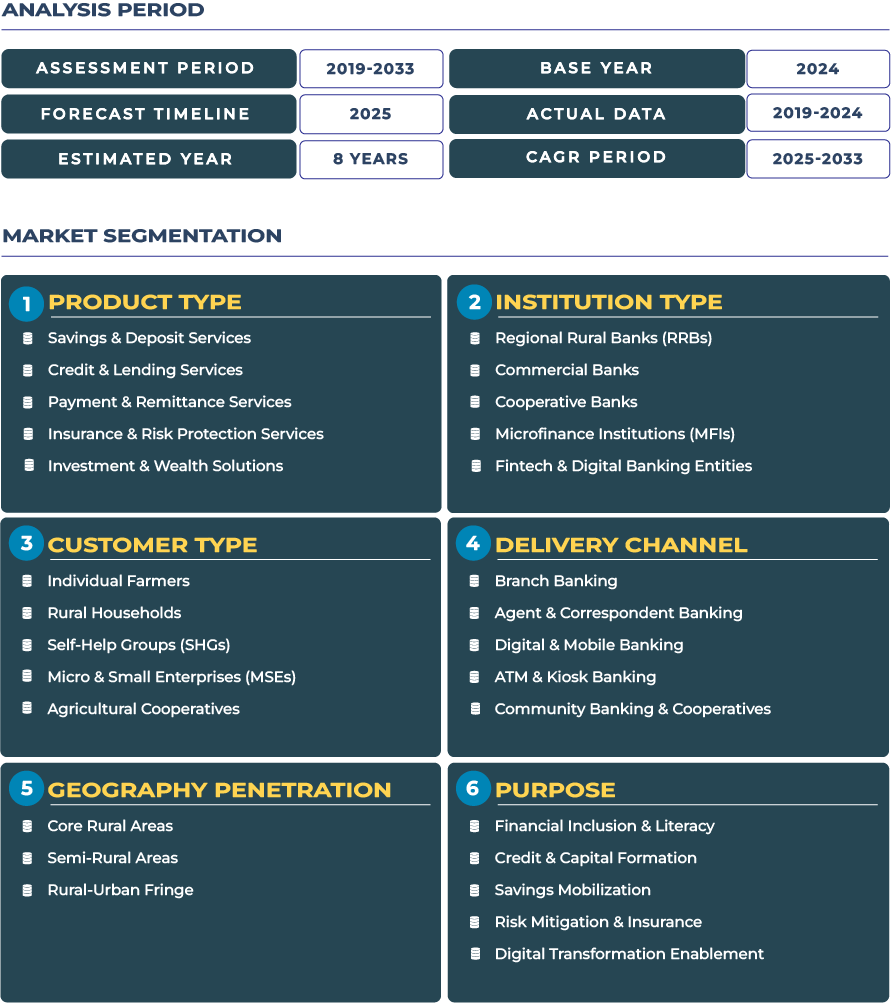Rural Banking in Saudi Arabia: Powered by Vision 2030’s Agri-Tech Momentum
The rural banking sector in Saudi Arabia is being fundamentally reshaped by the framework of Saudi Arabia’s Vision 2030 and its emphasis on agricultural diversification, rural innovation and youth entrepreneurship. Historically, rural finance in the Kingdom focused on basic deposit-taking and credit delivery in agricultural territories, but today it is evolving into a sophisticated ecosystem that supports greenhouse farming, desalination-linked irrigation, agritech venture funding and wealth‐creation solutions for rural households. In this context, the Saudi Arabia rural banking market is estimated to reach approximately USD 10.8 billion in 2025 and is forecast to grow to about USD 15.0 billion by 2033, representing a compound annual growth rate (CAGR) of around 4.2% from 2025 to 2033.
Note:* The market size refers to the total fees/revenue generated by banks through various services.
Saudi Arabia Rural Banking Market Outlook: Cultivating Financial Ecosystems for Rural Transformation Under Vision 2030
As Saudi Arabia navigates global commodity shifts, water-scarcity pressures and demographic transition, the rural banking industry is becoming a strategic pillar of value-chain financing rather than just local deposit-and-loan operations. The market’s outlook is underpinned by three major forces: the push to reduce food import dependency, the drive to engage youth and rural communities in agricultural entrepreneurship, and the need for banks to deliver integrated savings, credit, payments, insurance and investment solutions tailored to rural and agrarian contexts. The forecasted growth is justified by the rising demand for credit from agritech-enabled farmers, the scaling of controlled-environment agriculture (CEA) in arid zones, and the financial inclusion of rural migrants and youth entrepreneurs. Further, sovereign and fund-backed programmes provide rural banks with new mandates and capital flows, enabling them to roll out wealth-management and insurance-linked products into previously underserved rural pockets. Geopolitical stability in the region, improvements in rural digital infrastructure and the broader reform agenda of Vision 2030 strengthen this outlook. However, the market remains moderated by environmental constraints and labour-market dependencies and hence the moderate CAGR of rather than a rapid surge.
Growth Catalysts: Vision-Driven Rural Diversification Programmes and Sovereign-Backed Agri-Finance
Several structural drivers support the evolution of the rural banking ecosystem in Saudi Arabia. First, the Vision 2030 agenda explicitly promotes rural diversification, agritech investment and youth entrepreneurship which incentivises banks and financial institutions to expand credit, leasing and payment services into rural zones. For example, the Agricultural Development Fund (ADF) has provided soft agricultural loans exceeding USD 1.9 billion and has rolled out programmes to support farmers, greenhouse producers, aquaculture and dates production. Secondly, banks are aligning deposit mobilisation and wealth-solutions programmes with rural client segments, enabling savings flows from migrant labour, remittance networks and local cooperatives. Thirdly, technology infrastructure, particularly mobile banking, digital payments and agritech financing platforms, is enabling rural connectivity and credit delivery. With the agricultural sector contributing significantly to GDP (over USD 31.5 billion, according to the Ministry) and 52% reduction in non-renewable water usage in agriculture since 2016, the environment for rural finance is becoming more viable. Thus, these interplay of policy, infrastructure and market demand are driving the rural banking sector beyond traditional models.
Structural Constraints: Water-Scarcity, Soil‐Limitations and Migrant-Labour Credit-Profiling Challenges
Despite the compelling growth potential, the Saudi rural banking sector faces significant impediments. The Kingdom’s intrinsic aridity and soil constraints mean that domestic agricultural expansion is inherently limited, which restricts the extendable rural credit base for banks. The heavy reliance on expatriate labour in rural/agricultural zones complicates borrower profiling, credit scoring and repayment monitoring, increasing operational risk. Further, global commodity volatility, pandemic-driven supply-chain disruptions and regional geopolitical tensions introduce risk into value-chains that rural banks seek to finance. The regulatory and legal frameworks for new rural finance products, such as greenhouse-desalination linked loans or agritech equity financing, are still maturing in Saudi Arabia. Nonetheless, rural banks must navigate these constraints with prudence and adapt product design accordingly.
Emerging Trends & Strategic Opportunities: Green-Hydrogen-Ag Projects, Controlled-Environment Agriculture and Youth-Finance Platforms
A number of clear trends and opportunities are reshaping the Saudi rural banking landscape. One major trend is the financing of agricultural projects tied to green hydrogen and desalinated water, which opens up new asset-classes for rural lenders and aligns directly with the Kingdom’s energy-transition goals. Another trend involves subsidies and targeted financing for controlled-environment agriculture (CEA) in arid zones, allowing banks to underwrite projects with predictable yield profiles and lower climate risk. On the opportunity side, banks have a chance to develop integrated financing models that combine credit, leasing, insurance and wealth-solutions for rural entrepreneurs, particularly youth engaging in agritech start-ups or family-owned farm transitions. Between controlled-environment greenhouse loans, remittance-linked savings programmes for rural workers and micro-insurance for agrarian risks, the rural banking sector can unlock new windows of growth. As rural digital penetration improves and financial institutions embed themselves in the agrarian ecosystem, the opportunity set becomes richer and more diversified.
Competitive Landscape: Strategic Financing Models Anchoring Rural Banking Growth in Saudi Arabia
Leading financial institutions in the Kingdom are actively recalibrating their rural banking strategies to support agrarian value chains. For instance, Bank AlJazira is one of the named lenders providing agricultural finance and embedding sustainability and community-finance models as part of its rural banking footprint. Banks are pursuing dual strategies: one, providing structured finance for desalination-linked greenhouse and aquaculture projects, and two, launching youth rural-entrepreneurship funds and micro-finance vehicles targeting rural SME start-ups. For example, recent industry reports indicate that the Agricultural Development Fund approved SAR 5 billion (≈ USD 1.33 billion) of financing since early 2025, covering key sub-sectors like greenhouses, aquaculture and family-run slaughterhouses. These structural initiatives illustrate how rural banking in Saudi Arabia is shifting toward ecosystem financing rather than stand-alone credit books.







